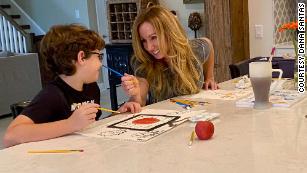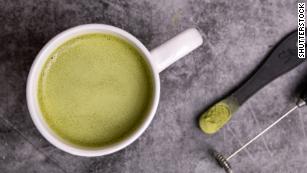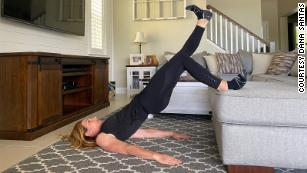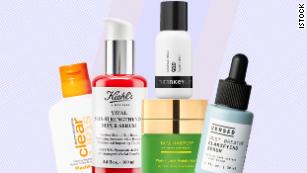Why a wellness routine is your top priority amid protests and the pandemic — and how to start
By Lisa Drayer, CNN
Updated 2:46 PM ET, Wed June 10, 2020
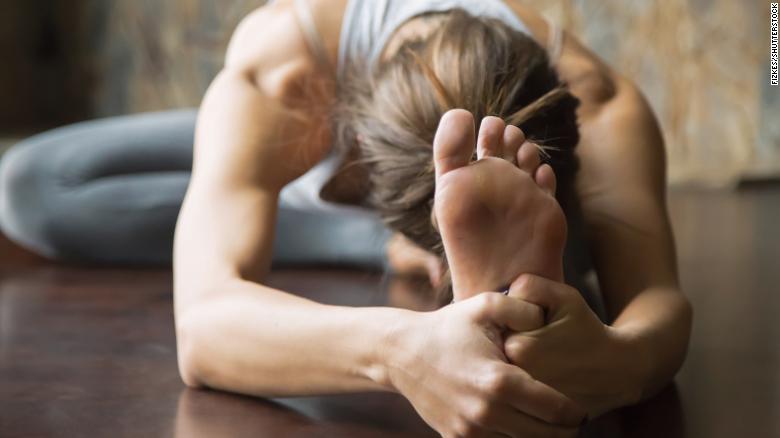
Incorporating a wellness routine into your schedule can help you weather the uncertainty of the times we live in. Here, a woman practicing yoga does a head-to-knee forward bend, or Janu Sirsasana pose.
(CNN)As states gradually reopen even as the pandemic wears on, many of us are concerned about our health and well-being. Especially now, with some continuing to stay at home and social distance while others join the throngs at nationwide Black Lives Matter protests, it may even be a priority.
From state to state, the loosening of restrictions vary, and within our local communities, the reality is that not only do people have different ideas on what constitutes social distancing but for many others still, in the face of racial inequality, the desire to create social change far outweighs the potential risk of spreading or catching the virus.
It's all the more reason to make sure we're taking the best care of ourselves to fortify against the disease. But while living a healthy life may be a desired goal, how to achieve it is another story.
Even if you're someone whose healthful habits were perfected to a tee during pre-pandemic times, you may find yourself struggling to engage in even the most basic self-care in these increasingly unpredictable days.
Content by CNN Underscored
Your guide to buying used iPhones
Breaking or losing an iPhone is a major pain, but there are a few options that won't break the bank for replacing it with a used or refurbished model.
That's where a wellness routine can come in handy.
close dialog
Covid-19
Your local resource.
Set your location and log in to find local resources and information on Covid-19 in your area.

I'm not talking about a spa escape every so often or even regular massages or chef-prepared meals (though all of that may sound really nice). I'm talking about creating your own personalized routine that will benefit you physically and emotionally, one that simply requires a regular commitment to yourself.
Creating a wellness routine allows you to shift from diet culture and adopt healthy habits that easily fit into your daily lifestyle. What's more, having a routine allows you to focus on health goals by creating structure and organization, which can be particularly beneficial when things seem out of your control, like life during an unprecedented pandemic and simultaneous upheaval as people fight against social injustice.
In fact, predictable routines, or ritualistic behavior "developed as a way to induce calm and manage stress caused by unpredictability and uncontrollability, heightening our belief that we are in control of a situation that is otherwise out of our hands," according to researchers at Tel Aviv University.
"We need an internal structure because our external lives have become totally unstructured — and that triggers anxiety and stress," said Robin Foroutan, a New York City-based integrative medicine dietitian and spokesperson for the Academy of Nutrition and Dietetics.
"In the beginning, we thought this was going to be a little break; a couple of short weeks, and then we'd resume life as we knew it. Now we know that probably is not going to be the case. We don't know how long this will last, but we can find ways to stay steady and structured on the inside amidst the chaos outside."
Engaging in a wellness routine with a focus on good nutrition, exercise, sleep and stress management can boost our health and well-being and strengthen our immunity during a time when we may need it most.
And while social obligations, travel and other commitments typically make it challenging to start new habits, being stuck at home without these distractions provides an opportune time to start creating a wellness routine that is accessible, doesn't require a lot of money and is something that you can count on during this uncertain time — and in the future, too.
How to create a wellness routine
Health experts say it's important to create a manageable routine that you can stick with as part of a lifestyle — not something overly ambitious that you can't sustain. One way to do that is to start small and build upon it, as you feel comfortable.
Here are some tips to get started in creating your personal wellness routine.
Set regular times for sleeping, eating and exercise
"Most people feel better when they are going to bed and waking up at consistent times, eating regular meals and snacks and getting a steady dose of exercise, said Marysa Cardwell, a registered dietitian, nutrition therapist and certified personal trainer based in Salt Lake City, Utah.
For sleep: Everyone's sleep schedule is different, and that's OK, as long as you stick to your natural circadian rhythms, experts say. That means going to sleep when the sun is setting (or a bit later) and waking up when sun is rising (or a little later, according to your individual needs).
Aiming for seven to nine hours of sleep is key, as it helps to "reduce the stress hormone cortisol and your adrenal load," Cardwell said.
Getting adequate sleep also bodes well for engaging in other healthful behaviors — by going to bed at a reasonable hour, you'll be less likely to engage in nighttime eating or mindless eating in front of the TV, and you're more likely to wake up early and start exercise, Cardwell explained.
For eating: Setting regular meal times, and taking a break to eat your food mindfully is key, Cardwell advised, but when you actually eat is up to you. "Some do well on three meals per day with an afternoon snack; others prefer three smaller meals and three snacks."
Regardless of the pattern you choose, aim to eat at least every four hours, which prevents blood sugar from crashing and can lead to overeating. For example, if you're eating three meals and one afternoon snack, you might choose to eat breakfast at 8 a.m., lunch at 12 p.m., a snack at 4 p.m. and dinner at 7 p.m.
Taking a few deep breaths, enjoying the wonderful smells of the food you are about to eat and chewing food really well can all help make mealtime a healthful ritual, Foroutan explained.
Additionally, dinnertime can become a daily social ritual by sharing the meal with family or friends, advised Jen Scheinman, a Denver-based registered dietitian nutritionist and owner of Jen Scheinman Nutrition, a virtual nutrition coaching practice. "Even a Zoom dinner with a friend if you're by yourself can help you feel connected."
For fitness: Pick a time that you're most likely to stick with. That might mean taking a morning walk before your day gets started, or scheduling your favorite fitness class on your calendar so you won't forget.
"I shut my day down with a run or yoga at around 5:30 p.m. That's my last thing for the day. The more you can make it a routine, the less you have to think about it," Scheinman said.
Plan for food, fitness and sleep
Planning what you will eat and how you will exercise means that you are more likely going to do what you intend to do, which will ultimately help you achieve your health goals. For example, planning meals in advance means you'll be less likely to reach for quick sugary snacks when you run out of energy. It also helps to limit shopping trips.
"Not only does planning your meals ahead of time help cut down on the number of times you're going to the grocery store, but it can also help reduce food waste and ensure you have meals that were intentionally picked to fit your nutritional goals," said Denver-based registered dietitian nutritionist Kelli McGrane.
For food: Eating a nutrient-rich breakfast sets the stage for making other healthful choices throughout the day.
Choose protein-rich breakfasts like egg whites, cottage cheese or smoked salmon on a bagel; Greek yogurt, smoothies with low-fat milk, high fiber cereals with milk or peanut butter on whole wheat toast.
Scheinman recommended preparing breakfast foods ahead of time, like making overnight oats with milk. "It makes the breakfast routine less daunting."
For lunch and dinner, Cardwell encouraged a fist-size portion of protein, such as fish, chicken or beans; a fistful of carbohydrates like whole wheat pasta or brown rice; and a half plate of veggies. This will help meet your micronutrient needs, as well as fiber. Use fats sparingly, as a condiment, to make your food taste better, but limit fried foods and saturated fat, Cardwell advised.
For snacks, choose protein and carb combos, like cheese with crackers, sliced fruit with peanut butter, nuts and seeds with dried fruit or Greek yogurt. Pairing protein with carbs "helps keep your blood sugar level stable, and helps you stay fuller longer," Cardwell said.
Scheinman recommended using the weekends for batch cooking, like making chili or soups, which you can freeze to enjoy later in the week. Washing and chopping veggies and fruit during the weekend can also save you time during the week.
For fitness: Pick a fitness activity that inspires you — and is doable. There are a lot of fitness apps offering free trials and online Zoom fitness classes, so you can use this time as an opportunity to try something new. Cardwell recommended aiming for at least 30 minutes per day, if possible.
If you are looking for a simple at-home cardio workout, MaryAnn Browning, founder and CEO of Browningsfitness in New York, recommended jumping jacks, high knees, butt kicks, burpees and switch jumps — during which you'll jump to turn 180 degrees and then back again — for 15 seconds each. Then repeat the circuit five to 10 times, depending on what you can handle.
For at-home fitness essentials, Browning recommended getting a set of yellow, green and red resistance bands, which can be used for back, bicep, triceps, shoulders and leg work. She also recommended looped bands to go around the calves or thighs, which strengthen the glutes and can help prevent knee and back injuries.
If you want to weight train but don't have equipment, anything that will give you muscle tension will be beneficial, such as jugs of water, books or even your children. "I use my kids — I'll do planks and have them sit on me ... or I'll do leg presses while letting them do airplane," Cardwell said.
And don't forget to keep moving throughout your day. Tracking apps like Lose It! are a good way to see how normal daily activities can all count toward our daily fitness goals.
"Dancing with your kids or partner, yard work, house projects, sex and cleaning are all trackable activities. Doing these activities with intention and extra vigor all count towards a healthy lifestyle," said Cardwell, who is also a contributing dietitian for Lose It!
For sleep: Engage in a bedtime routine where you can quiet down and prepare for sleep. "Turn off electronics, including the TV, iPad, and cell phones an hour before bedtime," Scheinman advised. This helps to reduce exposure to blue light, which "the brain perceives as daylight, so your brain is not quite getting the signal that it's nighttime and melatonin is not produced."
Unplugging also prevents you from checking one more email or scrolling through social media while in bed, which can be stimulating and interfere with sleep, Scheinman explained.
Other tips for a successful wellness routine: a morning ritual and self-care
Most experts recommended engaging in a morning ritual that brings you pleasure. "Starting your day with the same routine each morning can bring steadiness and calm to the rest of the day. You are starting from a more grounded and positive place, versus waking up; grabbing the phone and checking the news and getting stressed out," Foroutan said.
"The morning is a nice time to start integrating things you didn't have time for previously — like taking the dog for a longer walk in the morning, making a nice cup of coffee you can sit and enjoy or engaging in a meditation practice," Scheinman added.
"It sets the day off with a healthy intention, with a sense of comfort. ... I know this is what I do," Scheinman said.
Foroutan enjoys waking up and writing down three things she is grateful for. "Starting the day with a thought about gratitude can be really centering. Writing it down does something extra — it solidifies the thought and intention. Not every day is good but there's something good in every day. Even if it's one small thing that gives you a sense of gratitude — that's really grounding and it can help shift your perspective."
Stretching your body after you wake up or doing a sun salutation can help to get your blood flowing and your body moving in the morning.
Get CNN Health's weekly newsletter
Sign up here to get The Results Are In with Dr. Sanjay Gupta every Tuesday from the CNN Health team.
It's also important to prioritize self-care. "Make stress relievers like enjoyable activities a non-negotiable right now," Cardwell said. That may include knitting, taking an extra-long shower or bath, reading, taking a tea break, enjoying a glass of wine or calling family members. Even better, schedule these stress relievers into your day just like mealtimes and other obligations.
"We're taking stock of what's important ... and [our] health is important. Doing these things now can help you deal with the stress of right now," Cardwell said.
It can also keep you healthy and feeling good well into the future, too. That's a gift from quarantine life if there ever is one.
Lisa Drayer is a nutritionist, an author and a CNN health and nutrition contributor.




